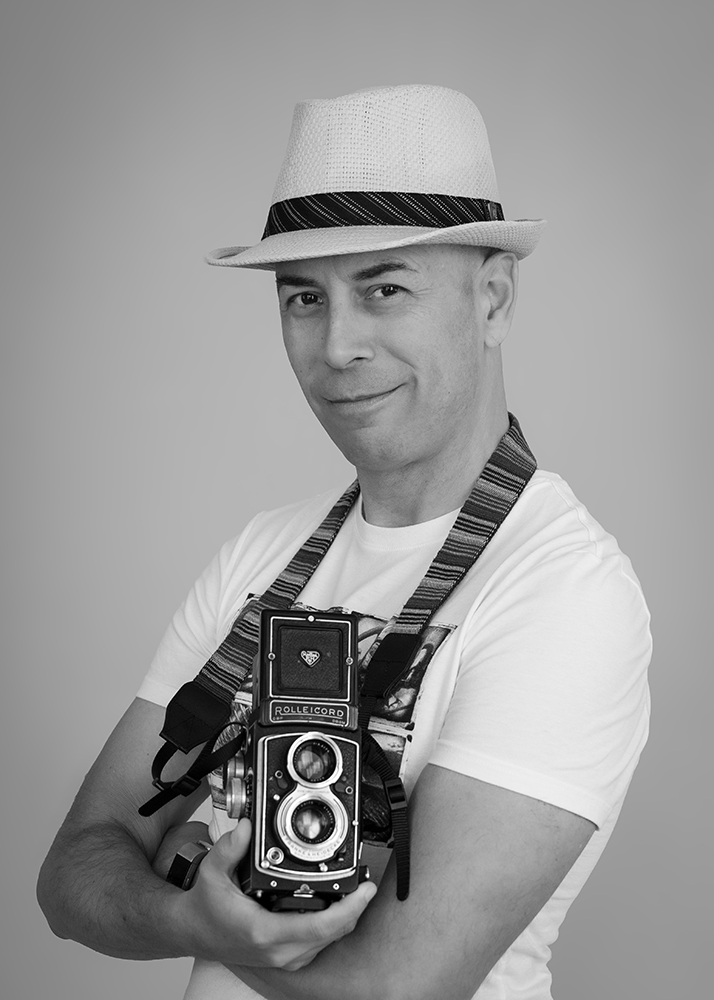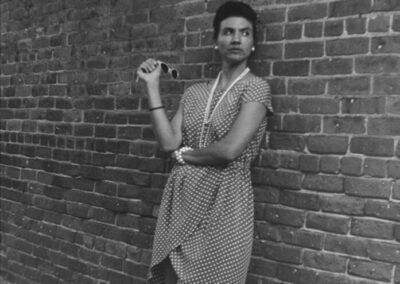Feature Image: Shaun with (Left to Right): Kodak Vigilant Junior SIX-20, Rolleicord V and Kodak Brownie Junior 616
Two years ago, a package from my sister arrived just in time for my birthday. Like a kid, I tore it open to discover something I had never laid eyes on before: a Rolleicord! I was thrilled to get this beautiful vintage camera, but at the same time, it was like welcoming an alien into my life. I had absolutely no idea how to operate it or what kind of film it would take, and it looked ancient. But that just lit my flame of curiosity so I started researching this strange creature like a mad man. How does a camera with two lenses even work? When I finally figured out how to open it, it was as though the heavenly gates of medium format film flung open and a bedazzling celestial light blinded me as angels burst into a chorus of symphonic harmony. Okay, maybe a touch melodramatic, but certainly entertaining. I was instantly catapulted into the uncharted realm of photography and, consequently, my work as a photographer would be forever changed.
It turned out that my Rollei was a Rolliecord V made between 1954-57. Yes, this is the same company that made the highly acclaimed Rolleiflex. The Rolleicord is the less expensive budget model yet has the same outstanding lens quality and precision focusing. The company of Franke & Heidecke kept a meticulous record of serial numbers making it easy to identify the vintage. With no internal light meter, I had to figure out how to get my exposure. I started out using a Tartisan two-dial light meter. I did not have very good luck with it. I then downloaded the My Light Meter Pro to my iPhone which really dialed in appropriate settings yielding lovely exposures. Just like downloading any app, I easily added it to my phone and I could program in and set the focal length, f-stop, image size (size of the negative i.e. 6 cm x 6 cm) and select the ISO. The app allows the photographer to easily adjust the ƒN and shutter speed for desired exposure results. After experimenting with a variety of 120 film stock, I decided that the Ilford HP5+ 400 really delivered my desired aesthetic of a silvery nod to the photography of the 1950s. The fun part was getting used to everything being flipped horizontally in the viewfinder making composition a bit of a game.
Now that I had unlocked the secrets of the Rolleicord, I felt confident I could resurrect the next relic. Beckoning me from the shelf was my Grandmother’s Kodak Brownie Junior Six-16. These were produced from 1934-42. 616 film was discontinued in 1984. I really wanted to photograph with the Brownie for the sake of touching a treasured piece of nostalgia knowing my Grandma dearly loved this camera and most of my mother’s baby pictures and early family photos from the 40’s were taken with this art-deco gem. In my research I found 616 adapters for 120 film. These worked well, but I also discovered it was necessary to trim the round edges of the 120 spools to align with the circumference of the adapter. If not, the spools were jamming and the film would not advance. Since films from this era were typically very low ISOs, the Ilford Pan F+ 50 performed very well in medium to bright light. The negatives are fun because they are 6 cm x 10.25 cm and can make lovely contact prints. On a roll of film, I will get four images. The numbers on the film backing of the camera do not line up in the film counter (a little round red window in the back of the camera), so instead, I count the number of rotations on the take-up spool knob. (2 1/2 turns gets it right).
But why stop at 616 cameras? Why not try 620 too? It was love at first sight when I saw the Kodak Vigilant Junior 620 produced between 1940-48. 620 is 120 film, the spool is what differentiates it from 120, the cut of the film is the same. Almost a point-and-shoot camera, it has a fixed shutter speed and four aperture settings ranging from ƒ12.5 – ƒ32. Mine is the “budget model” and features a Dak shutter. It is a “pocket camera” of sorts with a retractable lens and bellows that fold snuggly into a black steel case. This has been a lot of fun to travel with and will yield 8 6 cm x 9 cm images. The good thing is that the numbers on the film backing will align and you can actually track your images throughout the roll. You can purchase 620 film, but in my humble opinion, it is not worth the extra money. I re-roll my 120 on to original metal 620 spools. My word of advice is to not use plastic 3D printed 620 spools, they will get stuck in your vintage camera and potentially damage the springs and brackets in the film bay.
So, two years later, and over 100 plus developed rolls of 120 film and counting, the old soul in me loves to be out and about with my time capsules capturing images in the old-fashioned way and feeling as though I am touching a part of photographic history by keeping it alive.
If you get bit by this bug and want to dive into vintage camera work, let me know. I would be glad to be an accomplice in your endeavors.
Resources – Visit These Links
My Light Meter Pro to learn more about the app.
616 to 120 Spool Adapters on Ebay.
Rolleicord History

Shaun McFarland
Contributing Writer
Photography has been a part of Shaun’s life since he could grip a camera. In his early years, under the tutoring of his dad, he began operating a Pentax K1000 at the age of 11. His origins in photography began in the traditional darkroom and eventually evolved into the digital realm. While he enjoys the modern marvels of these digital dream machines, if he can create an image that might produce a nod of nostalgia, he will revel in that moment. Driven by a passion to breathe life back into vintage cameras, he has returned to medium format film and photographing with cameras that range from 1909 to 1989 and developing film and prints in a traditional wet lab. Shaun’s eclectic interests in photographic subject matter ranges from street photography, landscape, architecture to travel and portraits. He is driven by a curiosity that seeks to capture a sense of place and connection with the juxtaposed, other-worldly nature of black and white imagery. Shaun believes that traveling is the spice of life and gains much of his inspiration from surfing cultures and learning about life from people who are far different from himself.
Shaun’s world headquarters is located in Yuma, Arizona. Although born and raised in Wisconsin, he has lived on both coasts of the United States with the bulk of his time in Chicago, Il. He completed an Associate of.Arts in Theater Arts from Waldorf College, Forest City, IA and went on to graduate with his Bachelor of Arts in Speech Communications, Theater Arts and English Writing from Concordia College, Moorhead, MN. After graduating with a Master of Divinity from Wartburg Theological Seminary, Dubuque, IA, he had a brief career in ecclesiastical leadership roles and then went on to serve in several leadership positions in college academic advisement, career education admissions and human resources recruitment. When he is not busy behind the camera and producing photographic images, he manages the business operations of a medical clinic that he co-owns in the heart of Yuma. After three decades of accumulated work, he is now taking his photographic offerings public.
Contact Shaun




